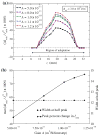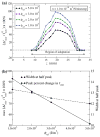Numerical modeling of long bone adaptation due to mechanical loading: correlation with experiments
- PMID: 20013156
- PMCID: PMC3412135
- DOI: 10.1007/s10439-009-9861-4
Numerical modeling of long bone adaptation due to mechanical loading: correlation with experiments
Abstract
The process of external bone adaptation in cortical bone is modeled mathematically using finite element (FE) stress analysis coupled with an evolution model, in which adaptation response is triggered by mechanical stimulus represented by strain energy density. The model is applied to experiments in which a rat ulna is subjected to cyclic loading, and the results demonstrate the ability of the model to predict the bone adaptation response. The FE mesh is generated from micro-computed tomography (microCT) images of the rat ulna, and the stress analysis is carried out using boundary and loading conditions on the rat ulna obtained from the experiments [Robling, A. G., F. M. Hinant, D. B. Burr, and C. H. Turner. J. Bone Miner. Res. 17:1545-1554, 2002]. The external adaptation process is implemented in the model by moving the surface nodes of the FE mesh based on an evolution law characterized by two parameters: one that captures the rate of the adaptation process (referred to as gain); and the other characterizing the threshold value of the mechanical stimulus required for adaptation (referred to as threshold-sensitivity). A parametric study is carried out to evaluate the effect of these two parameters on the adaptation response. We show, following comparison of results from the simulations to the experimental observations of Robling et al. (J. Bone Miner. Res. 17:1545-1554, 2002), that splitting the loading cycles into different number of bouts affects the threshold-sensitivity but not the rate of adaptation. We also show that the threshold-sensitivity parameter can quantify the mechanosensitivity of the osteocytes.
Figures










Similar articles
-
Modeling of cortical bone adaptation in a rat ulna: effect of frequency.Bone. 2012 Mar;50(3):792-7. doi: 10.1016/j.bone.2011.12.008. Epub 2011 Dec 22. Bone. 2012. PMID: 22210383
-
The establishment of a mechanobiology model of bone and functional adaptation in response to mechanical loading.Clin Biomech (Bristol). 2008;23 Suppl 1:S88-95. doi: 10.1016/j.clinbiomech.2008.01.016. Epub 2008 Apr 29. Clin Biomech (Bristol). 2008. PMID: 18448217
-
Determination of remodeling parameters for a strain-adaptive finite element model of the distal ulna.Proc Inst Mech Eng H. 2013 Sep;227(9):994-1001. doi: 10.1177/0954411913487841. Epub 2013 Jun 26. Proc Inst Mech Eng H. 2013. PMID: 23804949
-
Multiscale computational and experimental approaches to elucidate bone and ligament mechanobiology using the ulna-radius-interosseous membrane construct as a model system.Technol Health Care. 2012;20(5):363-78. doi: 10.3233/THC-2012-0686. Technol Health Care. 2012. PMID: 23079942 Review.
-
Stimulating effect of implant loading on surrounding bone. Comparison of three numerical models and validation by in vivo data.Clin Oral Implants Res. 2004 Apr;15(2):239-48. doi: 10.1111/j.1600-0501.2004.01000.x. Clin Oral Implants Res. 2004. PMID: 15008937 Review.
Cited by
-
Follistatin-like 3 is a mediator of exercise-driven bone formation and strengthening.Bone. 2015 Sep;78:62-70. doi: 10.1016/j.bone.2015.04.038. Epub 2015 Apr 30. Bone. 2015. PMID: 25937185 Free PMC article.
-
Patient-Specific Bone Multiscale Modelling, Fracture Simulation and Risk Analysis-A Survey.Materials (Basel). 2019 Dec 24;13(1):106. doi: 10.3390/ma13010106. Materials (Basel). 2019. PMID: 31878356 Free PMC article. Review.
-
Form follows function: a computational simulation exercise on bone shape forming and conservation.J Musculoskelet Neuronal Interact. 2015 Jun;15(2):215-26. J Musculoskelet Neuronal Interact. 2015. PMID: 26032215 Free PMC article.
-
Gene expression patterns in bone following mechanical loading.J Bone Miner Res. 2011 Jan;26(1):100-12. doi: 10.1002/jbmr.193. J Bone Miner Res. 2011. PMID: 20658561 Free PMC article.
-
Torsion - an underestimated form shaping entity in bone adaptation?J Musculoskelet Neuronal Interact. 2018 Dec 1;18(4):407-418. J Musculoskelet Neuronal Interact. 2018. PMID: 30511945 Free PMC article.
References
-
- ABAQUS Inc. ABAQUS Version 6.7 Documentation. 2008.
-
- Akhter MP, Raab DM, Turner CH, Kimmel DB, Recker RR. Characterization of in vivo strain in the rat tibia during external application of a four-point bending load. J Biomech. 1992;25:1241–1246. - PubMed
-
- Altair Hypermesh. Altair HyperMesh Documentation. 2007.
-
- Amira Amira User’s Guide. 2005. Numerical Modeling of Long Bone Adaptation. :603.
-
- Beaupré GS, Orr TE, Carter DR. An approach for time-dependent bone modeling and remodeling—theoretical development. J Orthop Res. 1990;8:651–661. - PubMed
Publication types
MeSH terms
Grants and funding
LinkOut - more resources
Full Text Sources

